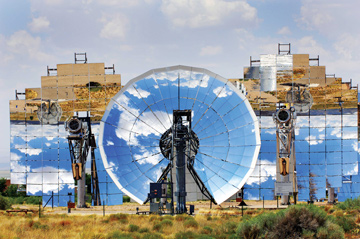New World Record for Solar-to-Grid Conversion Efficiency
New World Record for Solar-to-Grid Conversion Efficiency
mongabay.com
February 13, 2008
|
|
Sandia National Laboratories and Stirling Energy Systems (SES) set a new solar-to-grid system conversion efficiency record by achieving a 31.25 percent net efficiency, nearly a 2 point gain of the previous record of 29.4 percent set in 1984.
“Gaining two whole points of conversion efficiency in this type of system is phenomenal,” said Bruce Osborn, SES president and CEO. “This is a significant advancement that takes our dish engine systems well beyond the capacities of any other solar dish collectors and one step closer to commercializing an affordable system.”
According to Sandia National Laboratories, the record-setting solar energy system works as follows:
-
Serial #3 was erected in May 2005 as part of a prototype six-dish model power plant at the Solar Thermal Test Facility that produces up to 150 kilowatts (kW) of grid-ready electrical power during the day. Each dish unit consists of 82 mirrors formed in a dish shape to focus the light to an intense beam.
The solar dish generates electricity by focusing the sun’s rays onto a receiver, which transmits the heat energy to a Stirling engine. The engine is a sealed system filled with hydrogen. As the gas heats and cools, its pressure rises and falls. The change in pressure drives the pistons inside the engine, producing mechanical power, which in turn drives a generator and makes electricity.
 Sandia and Stirling Energy Systems set new world record for solar-to-grid conversion efficiency. The record establishes a new solar-to-grid conversion efficiency of 31.25 percent. The old record, which has stood since 1984, was 29.4 percent. |
Lead Sandia project engineer Chuck Andraka said that improved optics were key to the gains.
“The Stirling dishes are made with a low iron glass with a silver backing that make them highly reflective — focusing as much as 94 percent of the incident sunlight to the engine package, where prior efforts reflected about 91 percent.”
The solar dish also featured a new, more effective radiator and a new high-efficiency generator.
In the end though, weather played a big part in the achievement.
“It was a ‘perfect storm’ of sorts,” Andraka says. “We set the record on Jan. 31, a very cold and extremely bright day, a day eight percent brighter than normal.”